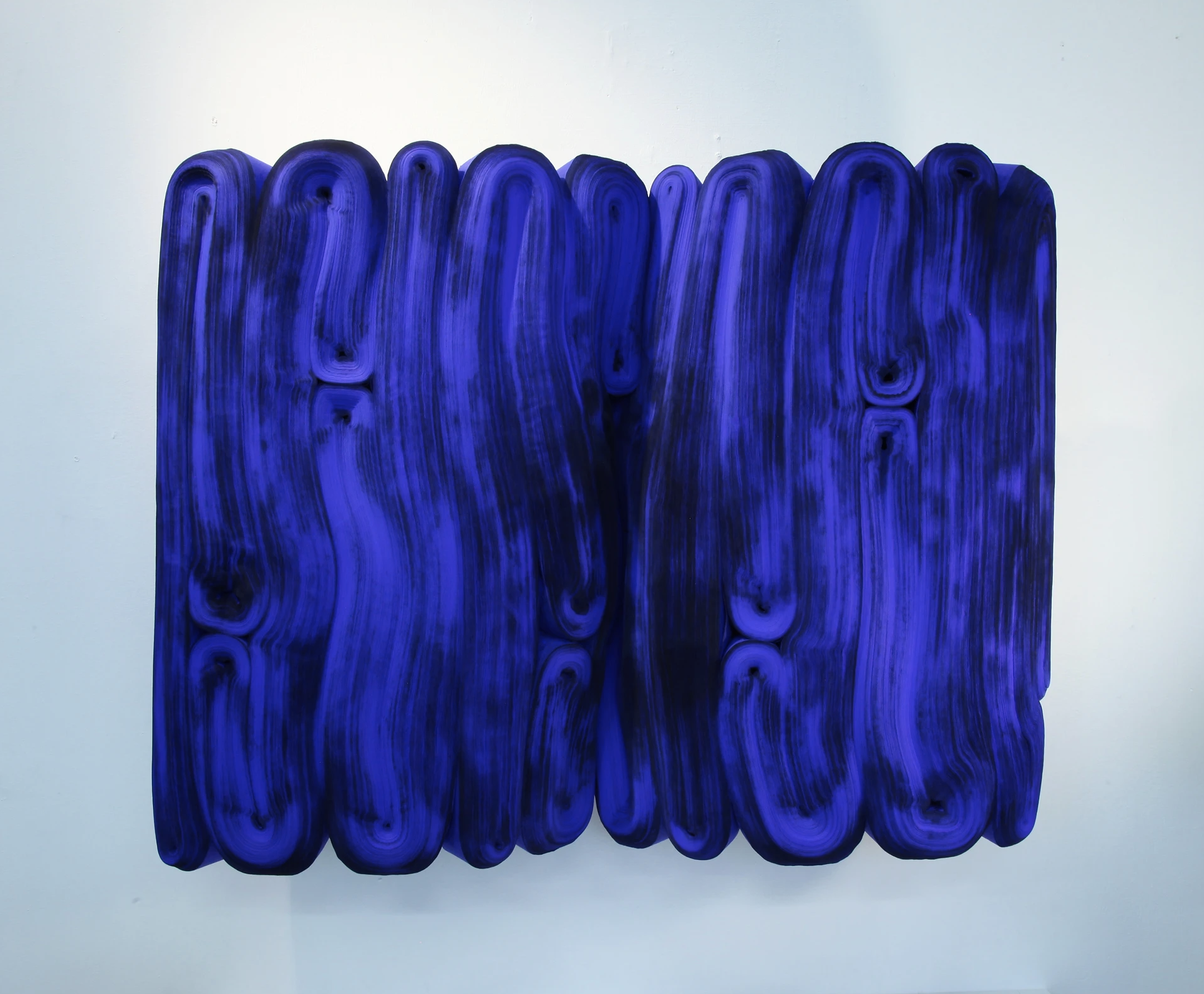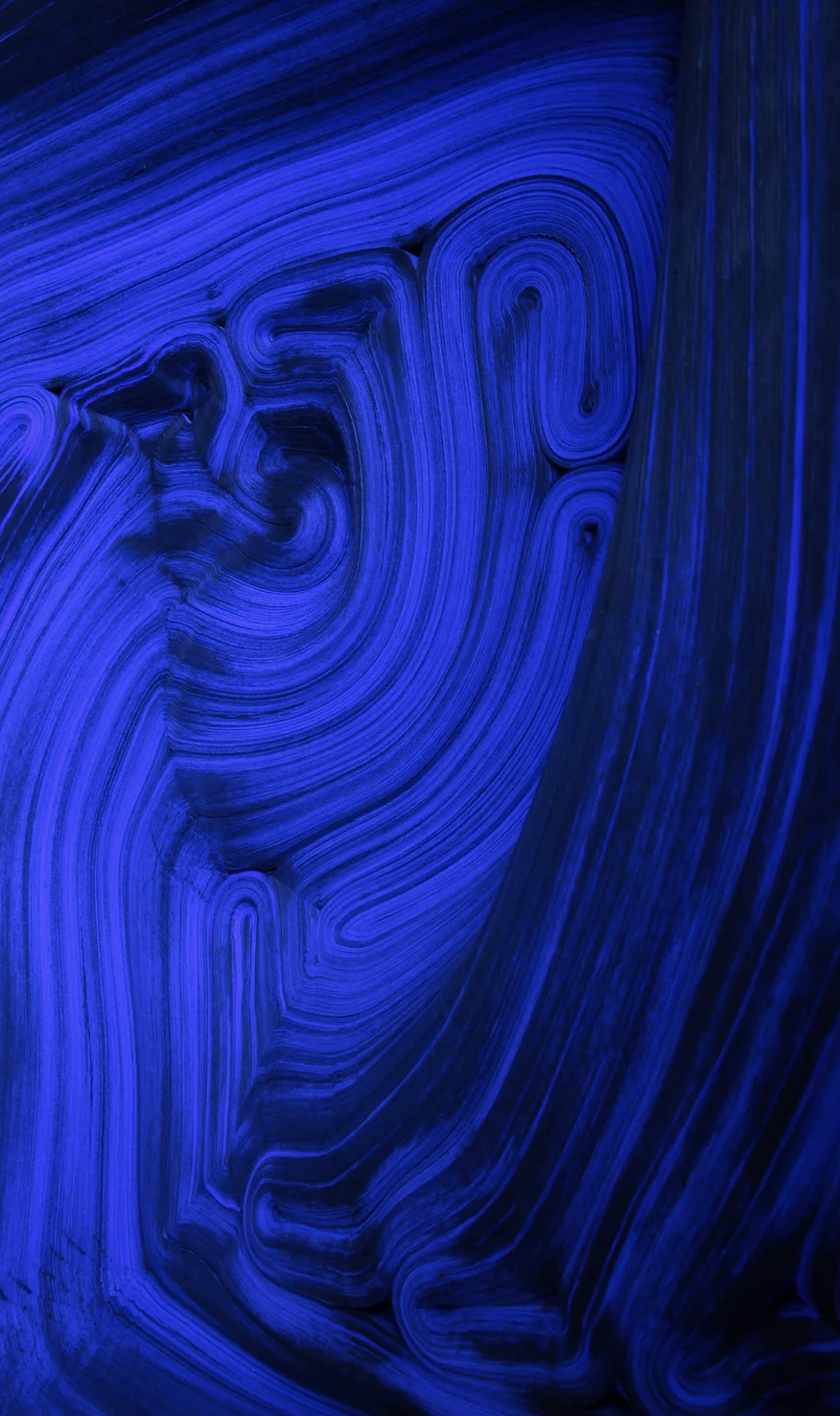
Jae Ko
enquire informationJae Ko’s artistic expression unfolds through elegant spirals and monumental ribbon installations, forming a distinctive visual language. Nature serves as her muse, with her sculptures mirroring organic elements like tree rings, tornadoes, roots, branches, or seeds. Initially inspired by trees, Ko incorporates sumi ink—derived from burned wood—into her creative process, intertwining it with paper as a nod to shared natural origins.
The intuitive design of Ko’s sculptures emerges from the transformation of everyday office materials, recycled paper, or adding machine tapes. Unwinding and reshaping these materials, she immerses them in ink-filled vats, allowing months for drying. The result blurs the boundary between writing and sculpting, with biomorphic forms resembling swollen calligraphic marks. Ko introduces color, drawing inspiration from the vivid hues of traditional Korean settings and adapting her influences as her environment evolves, incorporating Western elements.
Recognition for Ko’s work includes the 2002 Pollock-Krasner Foundation grant and the prestigious Anonymous Was A Woman Award in 2012. Notably, her installation “Force of Nature” was featured at The Phillips Collection in Washington, USA. Ko’s contributions adorn renowned private and public collections, including the Facebook HQ, Hirshhorn Museum, The Phillips Collection, The Corcoran Gallery of Art, and ADM.
Born in 1961, she pursued her artistic education in Japan, and later, an in Baltimore, USA. Residing and creating in Maryland, USA, Jae Ko continues to weave her unique artistic narrative, seamlessly blending cultural influences and the forces of nature.
jae ko in forbesWritten by Kristen Hileman, Curator of Contemporary Art at Baltimore Museum of Art:
During the 1990s in her initial explorations of water and paper—elements that have become integral to her sculptural practice,—Jae Ko buried brown, utilitarian Kraft paper in the sand along the ocean’s tide line. She recovered the material only after the water had repeatedly washed over it, sculpting it into a new form that reflected its ability to both respond to and withstand nature’s impact. Over the past decade, Ko has continued to pair the physical force of water, and more recently gravity, with the activity of her own hand to transform paper into shapes “rich and strange.” Not unlike the “sea-change” described in Shakespeare’s phrases from The Tempest, it is the time-based metamorphosis at work in Ko’s art—by which an ephemeral and everyday substance becomes a thing with an aura more unusual and enduring—that transfixes observers.
As the artist’s work evolved from her seaside experiments, she returned to the studio and began to build her sculptures from rolls of adding machine tape. For one such piece, Ko submerged rolls of the paper—with wedges roughly excised by box cutters—into pools blackened with Sumi ink. The resulting interlocking shapes—swollen, ink-saturated, and expanding into feathery networks of line along their cut edges—were then assembled into a formidable wall-like triptych which bore little resemblance to the mundane, “throw-away” stuff of its origin. Soon after this work, Ko began to remove the plastic centers of the modestly sized, commercially available rolls and laboriously re-wind the paper using a modified potter’s wheel, producing circular and ovoid forms that grew in size to the reach of a human arm-span. Once wrapped into a tight concentric form, each obsessively fashioned object was soaked in a distorting bath of ink. The result of this creative flux between control and chance is a series of sculptures that register a subtle and delicate complex of lines across their surface and a profound, velvety solidity. The works evoke a sense of geometry irregular yet elegant—a geometry suggestive of the intricacies of nature and experience, rather than the perfunctory tidiness of much manmade design. Indeed, in the tree-ring-like configurations of Ko’s sculptures, there seems a reclaiming of material (paper) from manufactured product to a more organic and poetic state.
Beyond these individual sculptures, which have been presented as wall reliefs and floor pieces, Ko has employed the same procedures of rolling and submerging paper to develop components that she arranges into larger wall-mounted sculptures, which often resemble a kind of three-dimensional calligraphy, albeit a mysteriously illegible text. The artist cites Japanese symbols signifying family identity as a reference (the Korean-born Ko studied art in Tokyo during the 1980s and has used calligraphic inks to stain some of her sculptures), but she also notes that there is a relationship between these and others of her sculpture to the landscapes she has encountered on travels to the American Southwest. Again, Ko’s fluid abstractions, hovering between script and topographical formations, strike an aesthetically rich balance between human invention/intervention and nature.
Although she has not abandoned her technique of immersion, in more recent years Ko has created cyclonic shapes by literally twisting and pulling her re-rolled paper forms into spirals and stabilizing them with painstakingly applied coats of glue. These forms might be installed singly so that they in effect launch off the wall; elsewhere they populate tumultuous floor installations. Paradoxically, in some ways engineered with less room for external circumstances to determine their final contours, these shapes present the eye with such multi-faceted interactions between interior and exterior, and between line and volume that the final sculptures appear to be roiling and random rather than carefully conceived structure. Ko enhances the baroque sensibility behind these sculptures by replacing the black palette that has dominated much of her output with a lush red coloration. The artist explains that she introduced red into her artwork as a way to “fight” with a color that she had always found contentious; the outcome of this struggle is visually energizing. She also periodically refrains from adding pigment to her binding medium, allowing layers of Elmer’s or carpenter’s glue to stand alone as an austere shell that nevertheless heightens the dramatic play of light and dark as the works react to the illumination of their surroundings.
Within the last year, Ko has cycled back to Kraft paper for new site-specific installations. Eliminating the variables of ink, glue, and water, Ko unwinds and then loosely coils the machine-rolled paper into more malleable modules, which she hand-presses into a kind of colony of distinct but related forms. In some instances, Ko’s rolls belly outwards, in others they recede into shadowy caverns, and in still others they thin into liquescent oblongs. The artist stacks these rolls, allowing gravity and the composition of the room in which the stacks are shown to complete the resolution of their shape and secure them into one interconnected mass. As with many of the artist’s strategies, the method behind this recent work seems to draw from the legacies of Fluxus and Minimalism, deploying the investigations into the operations of chance and time-based actions of the former movement to temper the serial repetition of shape, monochromatic color, and engagement with industrial materials and processes associated with the latter. Even in some of the formative works she made in Tokyo, signs of the opposing yet complimentary impulses of spontaneity and restraint were in evidence. From 1980 to 1981, Ko worked with blank pieces of white rice paper, crumpling each in her hands and then constructing minimal columns stretching from floor to ceiling with the re-flattened but textured sheets.
But just as the artist herself purposely avoids the influence of other artists—although she remains interested in art and architectural works by figures as diverse as Richard Serra and Antoni Gaudi,—her work evades being oversimplified as an extension of twentieth-century artistic categories. Instead, Ko melds a highly individualized technique and a focused sensitivity to material into what might perhaps be best termed her own practice of transformational abstraction.
Artworks
Impressions






















